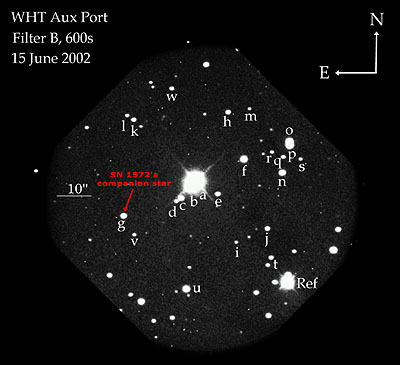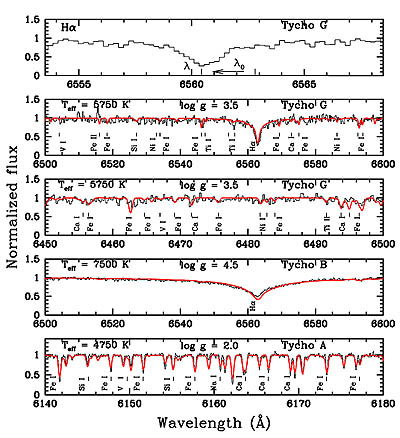WILLIAM HERSCHEL
TELESCOPE IDENTIFIES THE COMPANION STAR TO TYPE IA TYCHO BRAHE'S 1572 SUPERNOVA
WHT+UES, ISIS, AUX PORT CAMERA
The brightness of type Ia supernovae, and their homogeneity
as a class, makes them powerful tools in cosmology, yet little is known about
the progenitor systems of these explosions. They are thought to arise when
a white dwarf accretes matter from a companion star, is compressed and undergoes
a thermonuclear explosion. Unless the companion star is another white dwarf
(in which case it should be destroyed by the mass-transfer process itself),
it should survive and show distinguishing properties.
Tycho's supernova is one of only two type Ia supernovae observed in our Galaxy,
and so provides an opportunity to address observationally the identification
of the survi+ving companion.
A team of astronomers has carried out an imaging and spectroscopic survey
of the central region of Tycho's supernova remnant, around the position of
the explosion, which excluded red giants as the mass donor of the exploding
white dwarf. They also found a type G0–G2 star, similar to our Sun in surface
temperature and luminosity (but lower surface gravity), moving at more than
three times the mean velocity of the stars at that distance, which they claim
to be the surviving companion of the supernova.

|
Centre of Tycho's supernova remnant
(Tycho SNR). The star marked as 'g' is the one identified as the companion
star of Tycho Brahe´s 1572 supernova. Since the supernova explosion
in 1572, Tycho G has moved 2.6 arcseconds south on the sky and it is still
within a radius of 40 arcseconds centred on Chandra´s measured centre
of the X-ray remnant (40 arcseconds is 15% of the innermost radius of Tycho
SNR and taken as the error in the determination of the remnant centre).
[ JPEG | TIFF ]
|
Tycho G is a star of type G0-G2 IV located at the distance of Tycho SNR and
it moves in space at 136 km/s, which is a factor of over 3 larger than the
mean velocity of the surrounding stars (Tycho G´s metallicity in Fe
and Ni are similar to solar values and therefore it can´t be a halo
star). Its low surface gravity can also be interpreted as a consequence of
mass strip by the impact of the supernova explosion.

|
Model fits to observed spectra. The
stars shown here are the candidate star for the companion of SN 1572 (Tycho
G), a red giant (Tycho A) and main-sequence star (Tycho B) nearest to the
distance of SN 1572 and to the SNR X-ray centre. Identifications of the most
significant metal lines are given. Spectra were obtained at the William Herschel
Telescope with UES and ISIS. The upper panel shows the observed spectrum
near Hα. This line is blueshifted, implying a peculiar radial velocity exceeding
about 3 times the velocity dispersion for its stellar type. [ JPEG | TIFF ]
|
Some references:
- P.
Ruiz-Lapuente, F. Comeron, J. Méndez, R. Canal, S. Smartt, A. Filippenko,
R. L. Kurucz, R. Chornock, R. J. Foley, V. Stanishev & R. Ibata, 2004,
Nature, 431, 1069.
- D.
Branch, 2004, Nature News and Views, 431, 1044.
- "Stellar survivor
from 1572 A.D. explosion supports supernova theory", ESA Press Release, 27
October 2004.
- "La Supernova
de Tycho no estaba sola", IAC Press Release, 27 October, 2004.
- "Stellar
survivor from 1572 A.D. explosion supports supernova theory", NASA Press
Release, 27 October 2004.
- "Stellar
survivor from 1572 A.D. explosion supports supernova theory", UC Berkeley
Press Release, 27 October 2004.
- "432 years
lapse before Supernova perpetrator is identified", PPARC Press Release, 28
October 2004.
|




